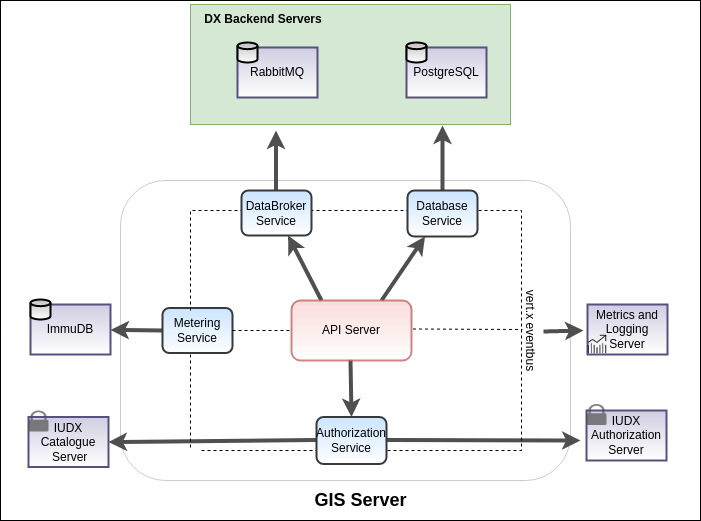The GIS interface is a resource server which defines the interactions between the consumers interested in GIS data and the upstream GIS Servers. The gis interface is IUDXs data discovery, data publication. It allows admins to publish their gis related info in accordance to the IUDX vocabulary annotated meta-data document. The consumers can access data from the gis interface using HTTPs.
- Provides data access from available resources using standard APIs.
- Integration with authorization server (token introspection) to serve private data as per the access control policies set by the provider.
- Allows admin to publish, edit or delete gis related info as per IUDX data descriptor.
- Secure data access over TLS.
- Scalable, service mesh architecture based implementation using open source components: Vert.X API framework, PostgreSQL for database and RabbitMQ for data broker.
- Hazelcast and Zookeeper based cluster management and service discovery.
The api docs can be found here.
The Gis-interface Server connects with various external dependencies namely
- PostgreSQL
- ImmuDB
- RabbitMQ
Find the installations of the above along with the configurations to modify the database url, port and associated credentials in the appropriate sections here
- Install docker and docker-compose
- Clone this repo
- Build the images
./docker/build.sh - Modify the
docker-compose.ymlfile to map the config file you just created - Start the server in production (prod) or development (dev) mode using docker-compose
docker-compose up prod
- Install java 13 and maven
- Use the maven exec plugin based starter to start the server
mvn clean compile exec:java@gis-server
- Install java 11 and maven
- Set Environment variables
export RS_URL=https://<rs-domain-name>
export LOG_LEVEL=INFO
- Use maven to package the application as a JAR
mvn clean package -Dmaven.test.skip=true - 2 JAR files would be generated in the
target/directoryiudx.gis.interface-cluster-0.0.1-SNAPSHOT-fat.jar- clustered vert.x containing micrometer metricsiudx.gis.interface-dev-0.0.1-SNAPSHOT-fat.jar- non-clustered vert.x and does not contain micrometer metrics
Note: The clustered JAR requires Zookeeper to be installed. Refer here to learn more about how to set up Zookeeper. Additionally, the zookeepers key in the config being used needs to be updated with the IP address/domain of the system running Zookeeper.
The JAR requires 3 runtime arguments when running:
- --config/-c : path to the config file
- --hostname/-i : the hostname for clustering
- --modules/-m : comma separated list of module names to deploy
e.g. java -jar target/iudx.gis.interface-cluster-0.0.1-SNAPSHOT-fat.jar --host $(hostname) -c configs/config.json -m iudx.gis.interface.database.archives.DatabaseVerticle,iudx.gis.interface.authenticator.AuthenticationVerticle ,iudx.gis.interface.metering.MeteringVerticle,iudx.gis.interface.database.postgres.PostgresVerticle
Use the --help/-h argument for more information. You may additionally append an RS_JAVA_OPTS environment variable containing any Java options to pass to the application.
e.g.
$ export RS_JAVA_OPTS="-Xmx4096m"
$ java $RS_JAVA_OPTS -jar target/iudx.gis.interface-cluster-0.0.1-SNAPSHOT-fat.jar ...
The JAR requires 1 runtime argument when running:
- --config/-c : path to the config file
e.g. java -Dvertx.logger-delegate-factory-class-name=io.vertx.core.logging.Log4j2LogDelegateFactory -jar target/iudx.gis.interface-dev-0.0.1-SNAPSHOT-fat.jar -c configs/config.json
Use the --help/-h argument for more information. You may additionally append an RS_JAVA_OPTS environment variable containing any Java options to pass to the application.
e.g.
$ export RS_JAVA_OPTS="-Xmx1024m"
$ java $RS_JAVA_OPTS -jar target/iudx.gis.interface-dev-0.0.1-SNAPSHOT-fat.jar ...
- Run the server through either docker, maven or redeployer
- Run the unit tests and generate a surefire report
mvn clean test-compile surefire:test surefire-report:report - Reports are stored in
./target/
Integration tests are through Postman/Newman whose script can be found from here.
- Install prerequisites
- Example Postman environment can be found here
- Run the server through either docker, maven or redeployer
- Run the integration tests and generate the newman report
newman run <postman-collection-path> -e <postman-environment> --insecure -r htmlextra --reporter-htmlextra-export . - Reports are stored in
./target/
We follow Git Merge based workflow
- Fork this repo
- Create a new feature branch in your fork. Multiple features must have a hyphen separated name, or refer to a milestone name as mentioned in Github -> Projects
- Commit to your fork and raise a Pull Request with upstream






